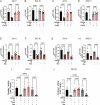Mechanisms by which statins protect endothelial cells from radiation-induced injury in the carotid artery
- PMID: 37404737
- PMCID: PMC10315477
- DOI: 10.3389/fcvm.2023.1133315
Mechanisms by which statins protect endothelial cells from radiation-induced injury in the carotid artery
Erratum in
-
Corrigendum: Mechanisms by which statins protect endothelial cells from radiation-induced injury in the carotid artery.Front Cardiovasc Med. 2025 Apr 11;12:1523371. doi: 10.3389/fcvm.2025.1523371. eCollection 2025. Front Cardiovasc Med. 2025. PMID: 40290194 Free PMC article.
Abstract
Background: The incidental use of statins during radiation therapy has been associated with a reduced long-term risk of developing atherosclerotic cardiovascular disease. However, the mechanisms by which statins protect the vasculature from irradiation injury remain poorly understood.
Objectives: Identify the mechanisms by which the hydrophilic and lipophilic statins pravastatin and atorvastatin preserve endothelial function after irradiation.
Methods: Cultured human coronary and umbilical vein endothelial cells irradiated with 4 Gy and mice subjected to 12 Gy head-and-neck irradiation were pretreated with statins and tested for endothelial dysfunction, nitric oxide production, oxidative stress, and various mitochondrial phenotypes at 24 and 240 h after irradiation.
Results: Both pravastatin (hydrophilic) and atorvastatin (lipophilic) were sufficient to prevent the loss of endothelium-dependent relaxation of arteries after head-and-neck irradiation, preserve the production of nitric oxide by endothelial cells, and suppress the cytosolic reactive oxidative stress associated with irradiation. However, only pravastatin inhibited irradiation-induced production of mitochondrial superoxide; damage to the mitochondrial DNA; loss of electron transport chain activity; and expression of inflammatory markers.
Conclusions: Our findings reveal some mechanistic underpinnings of the vasoprotective effects of statins after irradiation. Whereas both pravastatin and atorvastatin can shield from endothelial dysfunction after irradiation, pravastatin additionally suppresses mitochondrial injury and inflammatory responses involving mitochondria. Clinical follow-up studies will be necessary to determine whether hydrophilic statins are more effective than their lipophilic counterparts in reducing the risk of cardiovascular disease in patients undergoing radiation therapy.
Keywords: carotid stenosis; endothelium; mitochondria; prevention; radiation therapy; statin.
© 2023 Ait-Aissa, Leng, Lindsey, Guo, Juhr, Koval and Grumbach.
Conflict of interest statement
The authors declare that the research was conducted in the absence of any commercial or financial relationships that could be construed as a potential conflict of interest.
Figures







Similar articles
-
Short-Term Statin Treatment Reduces, and Long-Term Statin Treatment Abolishes, Chronic Vascular Injury by Radiation Therapy.J Am Heart Assoc. 2024 Jul 2;13(13):e033558. doi: 10.1161/JAHA.123.033558. Epub 2024 Jun 21. J Am Heart Assoc. 2024. PMID: 38904226 Free PMC article.
-
Short-term statin treatment reduces, and long-term statin treatment abolishes chronic vascular injury by radiation therapy.bioRxiv [Preprint]. 2023 Sep 22:2023.09.20.558723. doi: 10.1101/2023.09.20.558723. bioRxiv. 2023. Update in: J Am Heart Assoc. 2024 Jul 2;13(13):e033558. doi: 10.1161/JAHA.123.033558. PMID: 37790532 Free PMC article. Updated. Preprint.
-
Mitochondrial Ca2+ Uptake Drives Endothelial Injury By Radiation Therapy.Arterioscler Thromb Vasc Biol. 2022 Sep;42(9):1121-1136. doi: 10.1161/ATVBAHA.122.317869. Epub 2022 Jul 28. Arterioscler Thromb Vasc Biol. 2022. PMID: 35899616 Free PMC article.
-
Are statins created equal? Evidence from randomized trials of pravastatin, simvastatin, and atorvastatin for cardiovascular disease prevention.Am Heart J. 2006 Feb;151(2):273-81. doi: 10.1016/j.ahj.2005.04.003. Am Heart J. 2006. PMID: 16442888 Review.
-
Hydrophilic or Lipophilic Statins?Front Cardiovasc Med. 2021 May 20;8:687585. doi: 10.3389/fcvm.2021.687585. eCollection 2021. Front Cardiovasc Med. 2021. PMID: 34095267 Free PMC article. Review.
Cited by
-
Progression rate of radiation-induced carotid stenosis in head and neck cancer survivors after statin treatment: a retrospective cohort study.J Neurol. 2024 May;271(5):2573-2581. doi: 10.1007/s00415-024-12197-4. Epub 2024 Feb 8. J Neurol. 2024. PMID: 38332351
-
Cancer-Therapy-Related Cardiac Dysfunction: Latest Advances in Prevention and Treatment.Life (Basel). 2025 Mar 15;15(3):471. doi: 10.3390/life15030471. Life (Basel). 2025. PMID: 40141815 Free PMC article. Review.
-
Post-irradiation vertebral and carotid stenosis heightens stroke risk in head and neck cancer.BMC Cancer. 2025 Feb 11;25(1):235. doi: 10.1186/s12885-025-13647-6. BMC Cancer. 2025. PMID: 39934712 Free PMC article.
-
Radiation-Induced Macrovessel/Microvessel Disease.Arterioscler Thromb Vasc Biol. 2024 Dec;44(12):2407-2415. doi: 10.1161/ATVBAHA.124.319866. Epub 2024 Oct 24. Arterioscler Thromb Vasc Biol. 2024. PMID: 39445428 Review.
-
Radiation-Induced Cardiac Remodeling: Mechanisms and Therapeutic Approaches.Cardiovasc Toxicol. 2025 Jul;25(7):1022-1041. doi: 10.1007/s12012-025-10006-6. Epub 2025 May 29. Cardiovasc Toxicol. 2025. PMID: 40439873 Review.
References
-
- Atkins KM, Chaunzwa TL, Lamba N, Bitterman DS, Rawal B, Bredfeldt J, et al. Association of left anterior descending coronary artery radiation dose with major adverse cardiac events and mortality in patients with non-small cell lung cancer. JAMA Oncol. (2021) 7(2):206–19. 10.1001/jamaoncol.2020.6332 - DOI - PMC - PubMed
Grants and funding
LinkOut - more resources
Full Text Sources

